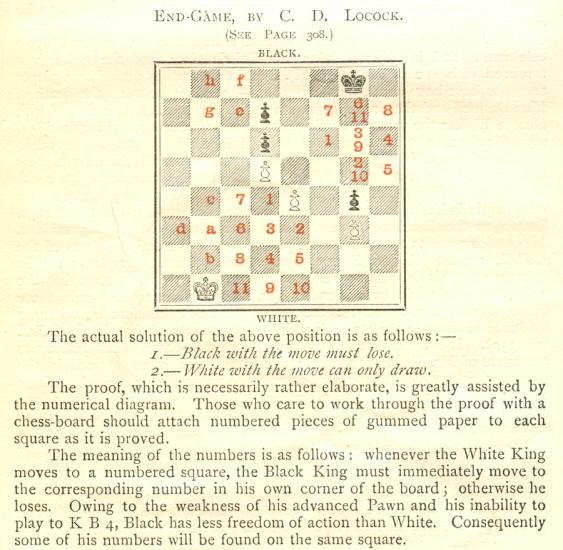Chess
Notes
|
| First column | << previous | Archives [55] | next >> | Current column |
5983. Who?

5984. Alapin’s
place of birth (C.N.s 5877 & 5882)
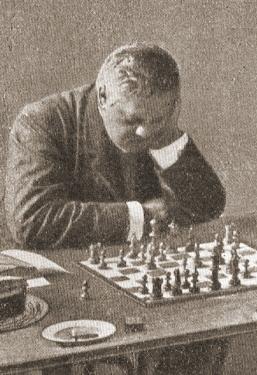
Simon Alapin
Martin Weissenberg (Savyon, Israel) provides the earliest published claim found so far that Alapin was born in Vilnius, and not St Petersburg:

Source: page 182 of Shakhmatny slovar edited by L.I. Abramov (Moscow, 1964).
5985. Oldest chess photograph (C.N. 5977)
Lawrence Totaro (Las Vegas, NV, USA) draws attention to the website of the Science & Society Picture Library. The illustrations yielded when ‘chess’ is typed in the search-box include two calotypes by William Henry Fox Talbot dated circa 1842.
Mr Totaro has also sent us page 18 of Sun Pictures Catalogue Eight: The Rubel Collection by Larry J. Schaaf (New York, 1997), which discussed the two pictures given in C.N. 5977. They were dated circa 1845, and there follows an extract from Dr Schaaf’s comments on them:
‘The most likely explanation of their authorship lies in Talbot’s close friendship with the London-based French scientist and photographer, Antoine Claudet (1797-1867). The Dutchman Nicolaas Henneman (1813-1898), Talbot’s one-time valet and photographic assistant, worked with Claudet, and these images have all the appearance of having been taken in Claudet’s studio. Henneman included one in his proposed 1849 Talbotype publication, providing a late dating, but indicating no authorship. It seems likely that these images were taken in Claudet’s studio, possibly by or with the assistance of Henneman.’
5986. Staunton picture (C.N.s 5942 & 5958)
We recall no publication of the full Staunton picture before David Lawson’s 1976 book on Morphy, but a detail appeared on page 56 of the January-February 1964 issue of Chessworld (to which Lawson was a contributor):

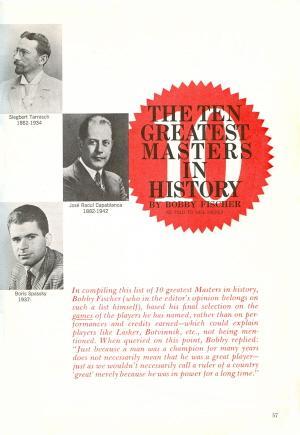
5987. The 1948 world championship in The Hague and Moscow

The above crosstable (reproduced from page 5 of Golombek’s book on the event) shows that there were, of course, five players and that they played each other five times. But ...

Page 10 of Raymond Keene’s book on the 2004 Kramnik v Leko match.

Page 7 of Raymond Keene’s book on the 2007 world championship match-tournament.

Page 11 of Raymond Keene’s book on the 2008 Anand v Kramnik match.
5988. Monograph on the Budapest Defence
Gábor Gyuricza (Budapest) refers to the booklet De Budapester Verdediging by St. Schwartz, which was published by J.L. Verbert, Markgravestraat 4, Antwerp. Undated, it came out in the late 1920s (in 1927 according to the catalogue of the chess library in The Hague). Our correspondent is seeking information about Schwartz, including his full name.
5989. Edward Lasker v George Thomas
Our feature article Chaos in a Miniature mentioned that page 26 of the January 1913 issue of La Stratégie gave a precise date for Edward Lasker’s brilliancy: 29 October 1912.
Tony Gillam (Nottingham, England) reports that according to the City of London Chess Club Annual Report for 1913 (page 37) Lasker joined the Club in October 1912. It may be recalled that on pages 147-148 of Chess Secrets I Learned from the Masters (New York, 1951) Lasker stated that he played the game at the City of London Chess Club on the day of his arrival in England.
5990. Staunton photographs (C.N.s 5942, 5958 & 5986)
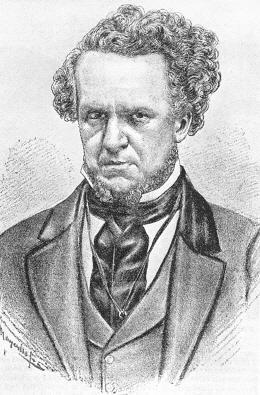
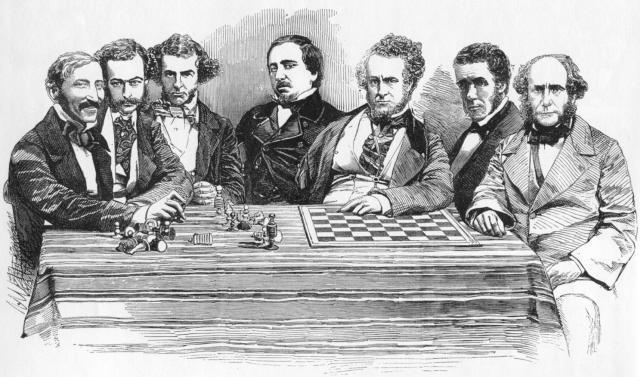
The above two illustrations appeared on pages 22 and 24 of Fred Wilson’s A Picture History of Chess (New York, 1981). Paul Dorion (Montreal, Canada) notes the close similarities in the portrayal of Staunton. Was the first picture copied from a photograph?
5991. Benjamin M. Anderson
Mark Thornton (Cambridge, England) raises the subject of Benjamin McAlester Anderson, Jr. (1886-1949), who wrote the Preface on pages v-xxix of Capablanca’s A Primer of Chess (New York, 1935). Basic biographical information about Anderson’s professional career is available on the Internet, but was he a strong chessplayer and why was he invited to write the Preface?
Certainly, his name is found only occasionally in the chess press. The example below is from page 91 of the July-August 1926 American Chess Bulletin:

In the Author’s Note in the US edition of A Primer of Chess Capablanca made the following presentation:
‘B.M. Anderson, Jr., Ph.D. is one of the world’s leading economists. He was professor of Economics both at Harvard and Columbia Universities, and he is today Economic adviser to one of the largest banks in New York City. His technical training included not only practical money and banking but also Philosophy, Sociology and Economic Theory. With it all he is a first-class chessplayer.’
The reviewer of the Primer on page 30 of the American Chess Bulletin, February 1935 was not impressed:
‘There is a long and, in some respects, a unique Preface by Dr Benjamin Anderson, the economist and a close friend of Capablanca’s. In his sketch of the author’s brilliant career he, so to speak, fairly paints the lily. Whether or not it was done with an eye on circulation it is hard to say, but this Preface, touching as it does upon several controversial matters, will arouse a storm of criticism, both here and abroad.’
The Preface was absent from the edition of the Primer published by G. Bell & Sons, Ltd., London, also in 1935.
Anderson and Capablanca remained in contact, and our collection contains a copy of a letter which Anderson wrote, from 1325 Warnall Avenue, Los Angeles, on 24 April 1940:

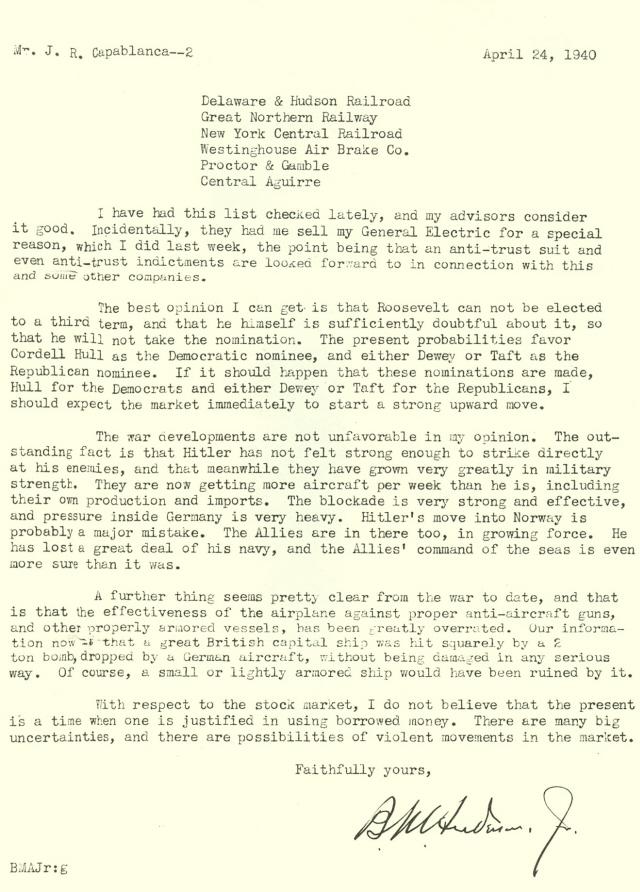
5992. Alekhine and Claparède
C.N. 5888 noted that the complete archives of the Journal de Genève are available online, and now Dominique Thimognier (St Cyr sur Loire, France) points out a report by the Genevese psychologist Edouard Claparède on page 5 of the newspaper’s 4 October 1925 issue. It concerns a ten-board blindfold exhibition given by Alekhine in Geneva three days previously and includes an explanation of how he played sans voir:
‘Je ne vois devant moi, m’a déclaré M. Alekhine, qu’une surface très vague, représentant l’échiquier, surface non colorée et vaguement divisée en casiers. Mais, si je puis me diriger dans ma partie, ce n’est pas parce que je vois les pions, mais parce que je sais où ils sont. Chaque case de l’échiquier a un sens pour moi, et chaque indication d’un coup correspond à un mouvement que je vois.’
Claparède also recounted that Alekhine submitted himself to some psychological tests. These indicated that in matters unrelated to chess (memorizing words, geometrical shapes and objects) Alekhine’s performance was average, whereas in memorizing chess positions he excelled. Claparède randomly placed 12 pieces (six white, six black) on a chessboard, and after looking at the position for 15 seconds Alekhine had perfect recall of where all the pieces stood:
‘M. Alekhine a bien voulu accepter de se soumettre, au laboratoire de psychologie, à quelques expériences, malheureusement trop restreintes, étant donné le peu de temps dont nous disposions. Elles ont suffi cependant pour montrer que, dans les domaines qui n’ont rien à faire avec les échecs (mémoire des mots, des figures géométriques, des objets), notre champion ne sort guère de l’honnête moyenne. Au contraire, dès que l’expérience de mémoire a pour objet un échiquier avec ses pièces, bond prodigieux: M. Alekhine laisse bien loin derrière lui les simples mortels que nous sommes. En voici un exemple: J’ai placé au hasard, sur un échiquier, 12 pièces, six blanches et six noires, comprenant les principales figures du jeu d’échecs. Après avoir regardé l’échiquier garni, pendant quinze secondes seulement, M. Alekhine est parvenu à rétablir d’une façon parfaitement exacte la position qu’occupait chacune de ces douze pièces. La même expérience, répétée avec deux collègues qui m’assistaient, et avec moi-même, n’a donné que trois à quatre reproductions justes sur douze.’
5993. Who?

Source: BCM, June 1940, page 194.
5994. The Jew of Chamant (C.N. 5842)

Having traced a copy of The Jew of Chamant, a novel which G.H.D. Gossip brought out in 1898 under the pseudonym Ivan Trepoff, Frederick S. Rhine (Park Ridge, IL, USA) has sent us a photostat of the complete work. He comments:
‘It is a vile book, virulently anti-Semitic but also very anti-Catholic and with negative references to South Americans, American Indians, a “nigger”, atheists, socialists and Romanians. The Preface (page 3) begins:
“In the Rogues’ Gallery of France there is no more conspicuous figure than the Jew of Chamant. Dickens and Harrison Ainsworth have well portrayed the Jew in all his revolting hideousness.”
Later on the same page the author states:
“My object in the present work is to paint the rich Jew in his true colors, as the enemy of society; to show that the Jew who steals millions can, in Europe, at any rate, defy the laws with impunity, and that he almost invariably escapes punishment owing to improper occult influences, and the mighty power of Israelitish gold.”
Towards the end (page 325) he even advocates genocide:
“Such is justice on the banks of the Seine! And such will probably continue to be the travesty of justice in la belle France until the massacre of the Jews – the Hebrew ‘St Bartholomew’ – threatened by Major Esterhazy at the Zola trial, has drenched the streets of Paris with the blood of that accursed race!”
On pages 260-261 there is a reference to chess and to Kolisch:
“The Champs Elysées in Paris are the veritable Elysian fields or paradise of la haute banque juive. The very names of the streets and avenues of this world famed thoroughfare of splendid equipages innumerable are Jewish, or have a pronounced semitic ring about them. At one end, near the Triumphal Arch, in the Rue Galilée, was the luxurious hotel of the great Hebrew banker, the late Baron Ignaz von Kölisch [sic], a poor devil literally without boots in the early ‘sixties’, who used to earn a precarious living by playing chess for a stake of a franc a game at the Café de la Régence in the Rue St Honoré, and was often half-starved; but who, by the usual Hebrew methods of a fraudulent bankruptcy, the support of the ‘Israelitish Alliance’ and the patronage of the Paris Baron Rothschild, became a millionaire and also, mirabile dictu, a full fledged Baron or ‘Freiherr’ of the Austrian Empire, and actually entertained on one occasion at his princely Château in Austria the Empress of Austria and her suite. This little, ill-bred Jew, whose manners were disgusting, entertained an Empress of the proud Imperial House of Hapsburg!”’
5995. Wallace v Capablanca
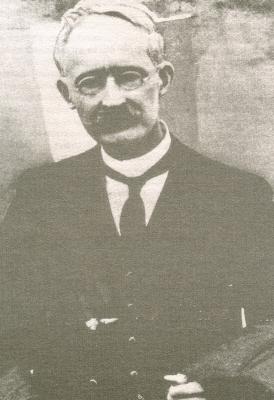
William Herbert Wallace
Among the quotes presented in our feature article Chess and the Wallace Murder Case are:
- ‘First: Wallace had “matched his brains against some of the greatest players in the world” – although, admittedly, it was always a pretty unequal contest. In the ’20s he had played in “simultaneous exhibition” matches when chess masters like Capablanca, Kashdan and Blackburne visited Liverpool and took on all-comers. Source: page 277 of The Killing of Julia Wallace by Jonathan Goodman (London, 1987).
- ‘Yseult Bridges, who also wrote about the case,
became convinced of Wallace’s guilt when she read a
series of “ghosted” articles about his life which
appeared in John Bull in 1932. There Wallace
remarks that he had matched his brains against some of
the greatest chessplayers in the world. Yseult Bridges
comments that “he was never more than a third-rate
player in an obscure little club”, and concludes that
Wallace was a pathological liar. But another writer,
Jonathan Goodman, looked more closely into the matter,
and concludes (in The Killing of Julia Wallace)
that Wallace was telling the truth after all; in the
1920s he had played in “simultaneous exhibition
matches” against world-famous players like Capablanca
and been thoroughly beaten.
Kenneth Gunnell, a parliamentary candidate from Redruth, Cornwall, independently discovered that Wallace was telling the truth about his chess opponents ...’ Sources: an essay by Colin Wilson in Unsolved Murders and Mysteries edited by John Canning (London, 1992) – see page 36. Also, World Famous Unsolved Crimes by Colin Wilson (London, 1992), page 91.
The grounds for Goodman’s conclusion about Capablanca and the other masters remain to be discovered, as does whatever Kenneth Gunnell may have ‘independently discovered’. Do any readers have access to his chess output? On page 191 of CHESS, March 1977 Gunnell reported:
‘I write a regular monthly column for Zugzwang! magazine, an occasional one (in French) for Le Courrier Des Echecs, and am a Contributing Editor of Mat!, although the last-named French-language monthly journal is not specifically concerned with postal play like the other two.’
5996. Mae Clarke v Capablanca
Lawrence Totaro (Las Vegas, NV, USA) sends this photograph of Mae Clarke (1910-92) with Capablanca in 1933:
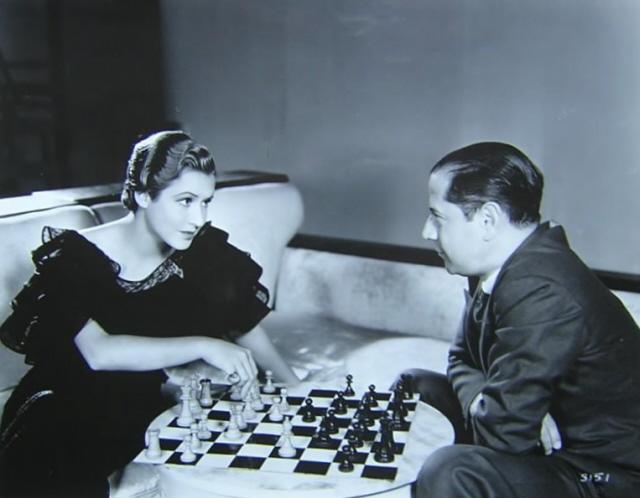
A typewritten paragraph on the reverse side states that Capablanca ‘was the guest recently of Mae Clarke, actress, on the Metro-Goldwyn-Mayer set making Turn Back the Clock’.
Capablanca was in Los Angeles in April 1933 (C.N. 4151). We see no mention of him in Featured Player An Oral Autobiography of Mae Clarke edited by James Curtis (Santa Barbara and London, 1996). The two photographs below come from that book:

5997. Tarrasch’s religion
João Pedro S. Mendonça Correia (Lisbon) asks about the accuracy of reports that Tarrasch converted from Judaism to Christianity.
His conversion is documented on pages 357-359 of Siegbert Tarrasch Leben und Werk by Wolfgang Kamm (Unterhaching, 2004). The opening sentence of the section reads:
‘Am 28. Mai 1909 tritt Siegbert Tarrasch, der Jude, zum christlichen Glauben über.’
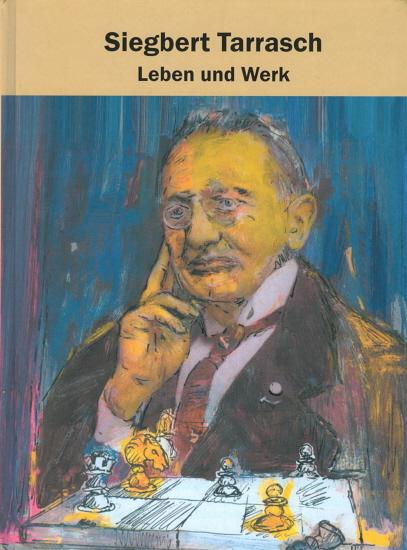
Kamm’s 877-page book (see C.N. 3462) offers by far the most detailed biographical treatment of Tarrasch but has received remarkably little attention.
5998. Staunton pictures (C.N.s 5942, 5958 & 5986)
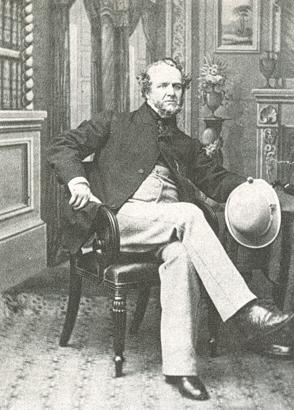
Michael McDowell (Westcliff-on-sea, England) points
out that this Staunton photograph was given on page 84
of The World of Chess by A. Saidy and N.
Lessing (New York, 1974), which was published two
years before David Lawson’s monograph on Morphy. The
illustration was credited to Lawson on page 248 of The
World of Chess.
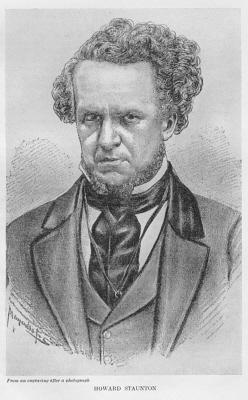
Regarding the above picture, John Townsend (Wokingham, England) notes that it appeared opposite page 164 of A Century of British Chess by P.W. Sergeant (London, 1934) with the reference ‘From an engraving after a photograph’. Mr Townsend also comments:
‘The name in the bottom left-hand corner is hard to read; the first word may be something like “Maguille”.’
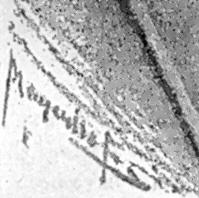
5999. Curt von Bardeleben
From pages 20-21 of Chess Secrets I Learned from the Masters by Edward Lasker (New York, 1951), in the section on Curt von Bardeleben:
‘He always wore a black cut-away suit of dubious vintage. Apparently he could never spare enough money to buy a new suit, although I learned one day that at fairly regular intervals he received comparatively large sums – from one to several thousand marks – through the simple expedient of marrying, and shortly after divorcing, some lady who craved the distinction of his noble name and was willing to pay for it. Unfortunately, when he received his reward, it was usually far exceeded by the amount of the debts he had accumulated since his last divorce. Evil tongues had it that the number of the ladies involved in these brief marital interludes had grown so alarmingly that they could easily have made up a Sultan’s harem.’
Can any independent corroboration of these claims be found?

Curt von Bardeleben
6000. Murray letter on Philidor
Dale Brandreth (Yorklyn, DE, USA) has sent us a copy of a letter dated 4 August 1932 from H.J.R. Murray to A.J. Souweine:
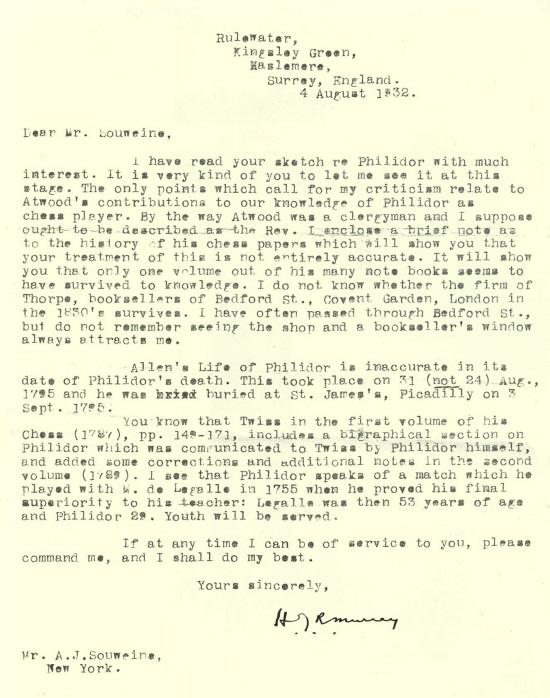
6001. Schallopp and draws
Page 3 of the Chess Player booklet Emil Schallopp (Nottingham, 2008) lists the master’s main tournament and match results (1864-1907). The totals are +163 –170 =38, and page 2 comments that ‘one extraordinary feature of Schallopp’s play is his small number of draws in major events’.

Emil Schallopp
6002. The Capablanca family
Another Capablanca photograph from Lawrence Totaro (Las Vegas, NV, USA) is given below:
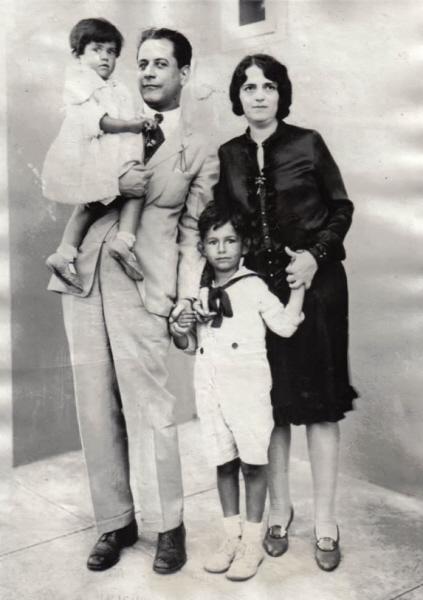
Capablanca is posing with his first wife and their two children. A note on the back of the photograph states that it was taken at their home in Havana, and the date given is 13 April 1927.
On page 17 of the sports section the New York Times of 1 April 1927 reported that Capablanca had returned to Havana after winning the New York tournament:
‘Traffic was blocked for an hour while several thousand persons who greeted the world’s champion cheered, set off aerial bombs and played music.’
6003. Corbis
Olimpiu G. Urcan (Singapore) notes that many fine portraits of chess masters (including Capablanca, Alekhine and Sultan Khan) can be viewed at www.corbis.com. The photograph of a young Capablanca (PL2114) was mentioned in C.N. 4575, with a comment about its date. Another excellent shot features Alekhine playing blindfold chess (U200877ACME), and we are aware of no chess publication which has used the photograph of Sultan Khan giving a simultaneous display (BE060856).
6004. Cases conjuguées
Luca D’Ambrosio (Bolzano, Italy) asks who coined the term ‘cases conjuguées’, which is usually translated into English as ‘conjugate squares’ or ‘sister squares’.
He notes that the issue arose in a dispute on the pages of L’Italia Scacchistica and L’Echiquier in 1932. At the end of June the Belgian magazine brought out the book L’opposition et les cases conjuguées sont réconciliées by Marcel Duchamp and Vitaly Halberstadt. Pages 273-274 of the 15 September 1932 issue of L’Italia Scacchistica published a hostile unsigned article (later identified as written by Stefano Rosselli del Turco) accusing the co-authors of plagiarizing Contributo alla teoria dei finali di soli pedoni by Rinaldo Bianchetti (Florence, 1925). Among the charges was the following:
‘Nel nuovo libro si riscontrano infatti non solo molte delle idee e dei metodi escogitati dall’Ing. Bianchetti, ma perfino gran parte della terminologia da questi adottata. Inoltre l’essenza stessa del libro, contenuta nel titolo, non è altro che la contraffazione della dimostrazione fatta da l’Ing. Bianchetti che l’opposizione è un caso particolare delle case corrispondenti o reciproche, o, se si vuole, delle case coniugate.’
The full article was reproduced, in the original Italian, on pages 1810-1811 of the 3 November 1932 issue of L’Echiquier, together with a half-page denial of plagiarism by Duchamp and Halberstadt. They claimed to have given Bianchetti’s book due credit and stated that, in any case, the phrase ‘cases conjuguées’ predated Bianchetti, having been used by Przepiórka in Munich in 1908:
‘Par esprit d’équité historique nous devons reconnaître D. Przepiórka comme l’auteur de cette phrase si importante dans l’article cité: “L’opposition est un cas particulier des cases conjuguées.” Ceci se passait à Munich en 1908! La question des cases conjuguées n’est pas née en 1925.’
Mr D’Ambrosio asks what contribution Przepiórka made to the subject in 1908.
6005. Philidor’s death-date
Further to C.N. 6000, Michael Clapham (Ipswich, England) comments that although H.J.R. Murray’s letter, written on 4 August 1932, stated that Philidor died on 31, and not 24, August 1795, page 865 of his History of Chess (Oxford, 1913) gave 24 August.
We note that there was doubt about the correct date until the mid-1920s. On page 435 of the October 1926 BCM John Keeble wrote:
‘Two new facts have come to light concerning Philidor. Twiss gave the date of his death as 24 August 1795 and supported that statement by quoting a long obituary notice which he said appeared in the London papers of 29 August of that year, but The Times, in Mr Tinsley’s fine bicentenary article, points out that the death of Philidor appeared in their paper on Wednesday, 2 September as occurring on Monday, 31 August, which date I think is undoubtedly correct. I find it confirmed in a local weekly; the Norwich Mercury, of Saturday, 5 September 1795, in their London news, said: “Philidor, the great chessplayer, died on Monday”, again indicating 31 August.’
On page 688 of the November 1926 BCM G.H. Diggle pointed out that Staunton had given the date 31 August 1795 in reply to a correspondent on page 284 of volume one of the Chess Player’s Chronicle.
6006. Who?
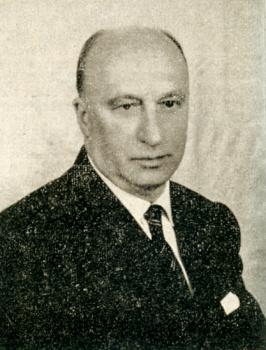
6007. Masefield/Mansfield/Mayfield v Trinka/Trinks/Trent
Regarding the alleged three-move game discussed in
C.N.s 3295 (see pages 253-254 of Chess Facts and
Fables), 4493, 4506 and 4994, Frederick S. Rhine
(Park Ridge, IL, USA) draws attention to the following
on page 4 of Chess Life, 20 October 1959:

The game which had been given on page 3 of the 20 August 1959 Chess Life was F. Arnold v M. Hanauer, Philadelphia, 1936: 1 d4 Nf6 2 c4 e5 3 d5 Bc5 4 Bg5 Ne4 5 Bxd8 Bxf2 mate.
6008. M.I.R.I.
Rod Edwards (Victoria, BC, Canada) writes:
‘Page 162 of volume one of Jeremy Gaige’s Chess Tournament Crosstables (Philadelphia, 1969) lists a player named “M.I.R.I.” as a participant in Section II of the Groningen tournament in 1896. Gaige’s source is Tijdschrift van den Nederlandschen Schaakbond, 1896, page 266. Who was the player and what do the initials stand for?’
Jurgen Stigter (Amsterdam) points out that on pages 264-265 of that issue of the Dutch magazine (December 1896) a report on the tournament by H.D.B. Meijer referred to ‘J.J.R. Moquette (M.I.R.I.)’. An explanation for the pseudonym has yet to be found.
6009. Which rook? (C.N. 5954)
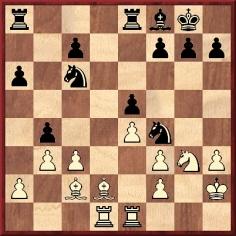
Position after 21 Rfe1
Concerning Tartakower v Réti, New York, 1924, David DeLucia (Darien, CT, USA) informs us that he owns Réti’s score-sheet, which clearly indicates that 21...Rad8 was played. Since that was also the move given by Tartakower (as shown in C.N. 5954), it seems evident that the English-language edition of the tournament book by Alekhine was wrong.
Regarding the nine-page errata supplement issued by W.H. Watts in 1925, see C.N.s 5954 and 5955.
6010. Burn game? (C.N.s 2837, 2843 & 4455)
We now have 200 megnyitási sakkcsapda by Emil Gelenczei (Budapest, 1958). The Burn game under investigation (for the full score see C.N. 4455) was given on pages 91-92 with the mere heading ‘Amatőr-Burn’, although in the index (page 140) Burn was one of the very few players to be listed with an initial (A.). No pre-1958 publication of the game has yet been found.
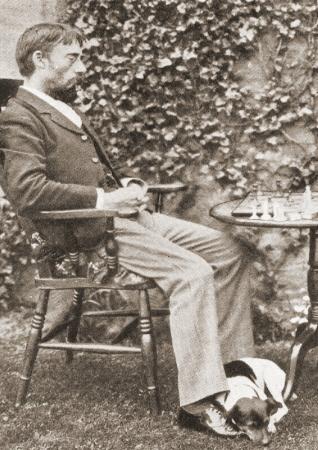
Amos Burn
6011. Cases conjuguées (C.N. 6004)
From Harrie Grondijs (Rijswijk, the Netherlands):
‘On pages 24-25 of the second edition of my small book Four Endgame Studies by Emanuel Lasker (Rijswijk, 2008) I wrote that the Akademisches Monatsheft für Schach, May-June 1908 mentioned a talk by Dawid Przepiórka which I believe made it into print only in the Berliner Lokalanzeiger, although I have not seen what that newspaper published. I also noted that the talk was criticized by Johann Berger on pages 115-119 of the April 1909 Deutsche Schachzeitung. Berger referred to the principle of “eindeutige Beziehung”, which may be translated as “one-to-one relationship” and is not far removed from “conjuguées”. It is not clear to me whether Przepiórka used that particular phrase or whether Berger introduced it in his review.
Page 31 of my book gave the first use of the word “corresponding” in this context, from the start of a feature by C.D. Locock on pages 396-399 of the September 1892 BCM:
Finally, on page 34 I reproduced te Kolsté’s table with corresponding squares, from page 59 of the March 1902 Tijdschrift van den Nederlandschen Schaakbond.’
With regard to Przepiórka’s talk, can a reader trace what the Berliner Lokalanzeiger published?
6012. Berger
game
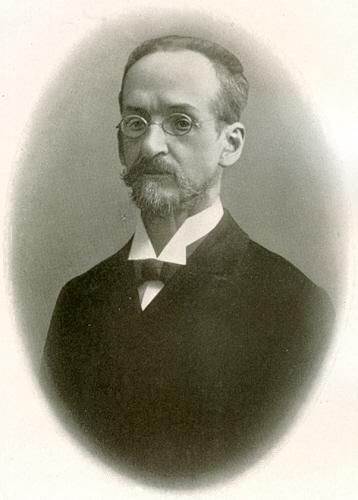
Johann Berger
A game on page 251 of Probleme Studien und Partien by J. Berger (Leipzig, 1914):
Johann Nepomuk Berger – StreisslerGraz, October 1883
Falkbeer Counter-Gambit
1 e4 e5 2 f4 d5 3 exd5 Qxd5 4 Nc3 Qd8 5 fxe5 Nc6 6 Nf3 Bg4 7 Bb5 Ne7 8 O-O a6 9 Ba4 b5 10 Bb3 Nxe5 11 d4 Nxf3+ 12 Rxf3 f6 13 Ne4 Nc6

White to move. What did he play?
6013. Book title (C.N. 1963)


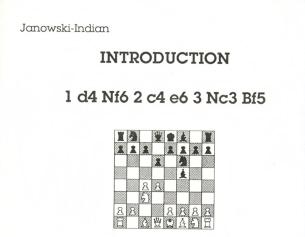
| First column | << previous | Archives [55] | next >> | Current column |
Copyright: Edward Winter. All rights reserved.
